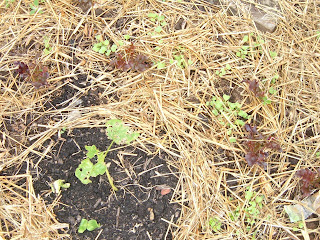
Last weekend Lauren and I taught a day-long "homescale organic gardening" workshop. We focused on how to grow food in this climate utilizing whatever space is available. Participants had gardens ranging from a few potted tomatoes on a back deck to several acres under stewardship. The D Acres gardens provide examples of these varying degrees of scale that are applicable to home gardeners and market growers alike. We discussed composting, planted hops and elderberry, and created this garden bed..

Last year, this was a compost pile on the edge of our orchard. We have since used the compost and were left with a nice base of organic material, under which the grass had decomposed. We just gave it a quick forking and laid cardboard covered with woodchips around the perimeter to prevent any weeds from creeping in. The wooden box is a simple cold frame.

We then made some compost mounds and planted winter squash, surrounded by lettuces and direct seeded radishes. The radishes should be ready to harvest by the timethe winter squash is big enough to occupy that area, and the lettuce will probably be going to seed by then. Extra winter squash seeds were planted with the squash transplants to ensure that if our plants did not acclimate well, there would be another crop behind it. With such a short season and limited growing space, we need to maximize our garden beds and think at the square-foot level. Notice the damage on the squash plant caused by striped cucumber beetles. Good thing we planted extra seeds!

This is the plant that was covered by the cold frame, which provides shelter from intense sun, fierce winds, heavy rain drops, and most importantly, the voracious appetite of striped cucumber beetles. These insects are particularly abundant this year due to our mild winter, which was not cold enough to significantly reduce their overwintering populations. This season has been great so far though. The rains have come when we needed them, the sun has been shining, and the temperatures above average. All in all, the plants (and weeds) are growing strong and we have been working hard to take care of them.

There is an abundance of fresh vegetables, flowers, and herbs that we can all grow in our yards with some effort and intention, creating biodiverse ecosystems that are not only healthy for humans, but also for bees, hummingbirds, worms, and native wildlife. Hopefully some of these age old practices will take root in people's yards and communities, inspiring neighbors and friends to grow food instead of lawn on their piece of Earth.
-be

2 comments:
Take a look at the flower boxes at the convenience store on S.Main st in Plymouth. Last year a few people even got to eat out of them.
I love your garden. My wife and I are attempting to go green with our own indoor and outdoor garden. We are hoping composting helps.
Post a Comment